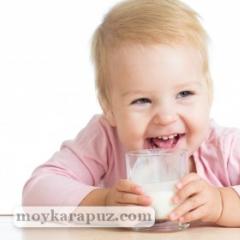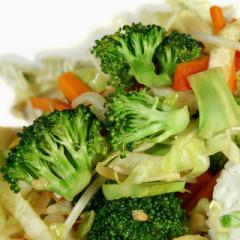Baby's diet at 1 year and 3 months
The digestive system of children continues its gradual development, as does the chewing apparatus. Dishes retain their former soft consistency, but it is useful to include small pieces in food. Mashed potatoes, chopped with a blender, are gradually replaced by vegetable stew, mashed with a fork. And meat can be included in the diet in the form of steam cutlets.
You should not postpone the introduction of more solid food until later, to prevent the organs of the digestive tract from becoming lazy and lethargic. If the child eats exclusively semi-liquid and liquid dishes, blood flow to the intestines and stomach is reduced, the development of the enzyme apparatus is inhibited, which will lead to further weakening of the muscle layer of the digestive tract.
By the year children have at least 10 milk teeth, with the help of which they can comprehend the science of chewing, moving to a new level of nutrition. The sooner solid food is introduced, the faster the baby will learn important chewing skills. A modified diet not only increases the nutritional value of dishes, but also helps to expand the gastronomic knowledge of children.
As for breastfeeding, the regimen is reduced to a minimum. The baby only needs morning and evening feeding before bedtime, but there is nothing wrong with night meals. They are an excellent prevention of caries and help reduce the excitability of children. If the baby still eats mother’s milk, do not wean it.
Feeding time and quantity

Up to 18 months inclusive for the child, the regime of five meals a day is maintained. It is possible to reduce the number of feedings if the child does not eat himself for the fifth time. A more “adult” diet consists of breakfast, lunch, afternoon snack and dinner, and the interval between meals should not exceed 4 hours. During this period of time, food passes from the baby’s stomach to the intestines - and the child is ready to eat again.
Having established the schedule, one should not deviate from it for more than half an hour, since the food reflex contributes to good appetite and full digestion. Proper nutrition includes the absence of snacks between main meals, including juices, fruits, sweets and dairy products. A little connivance on the part of the parents will lead to a decrease in the child’s appetite and a possible rejection of the main course. A convenient cheat sheet for mom will be a table according to which you can make a baby’s diet.
Calorie content
Products
The nutrition of a one-year-old baby can be safely called diverse, since every month, starting from the age of 8 months, my mother included a new product in the diet. However, much remains unknown that should be added carefully, observing the reaction and well-being of the child.
At 1 year, pediatricians are divided into two periods: from a year to one and a half and from one and a half to two years. The first period does not make any significant changes in the diet or in the methods of cooking. All dishes at this age are fed mainly in the form of mashed potatoes (mashed) and are given to the baby mainly from a spoon.
At this time, the child learns to chew food and only then swallow it. This is a kind of preparation for the assimilation of more coarse food - pieces, lumps.
The pacifier and bottles need to be gradually removed, since the baby, accustomed to liquid food, often refuses any other kind of it (including mashed potatoes).
A 1 year old baby requires regularity (hourly feeding).
The optimal during this period should come close to such a schedule:
8.00 - rise and morning toilet
8.30 - breakfast
9.30-12.00 - walks
12.30 - lunch
until 4 p.m. - sleep
16.30-17.00 - afternoon tea
17.00-18.30 - walk
19.00-19.30 - dinner
from 20.30 - a dream
23.00 - night feeding (if necessary)
Of course, this schedule is approximate. The main goal we are striving for is compliance with the “eat-walk-sleep” regime. By the way, a walk does not mean only riding a child in a stroller. This must include communication and age-appropriate games.
 Forcing the baby to observe the newly established regimen would be wrong. This is double stress for both the child and the mother. Therefore, implement plans gradually. If, for example, a baby wakes up earlier than 8:00, try to withstand an hour and a half break between sleeping and feeding. As a last resort, let him have a bite to eat with something light (like vegetable or fruit puree). Do not limit the crumbs in drinking - he should drink as much as he wants.
Forcing the baby to observe the newly established regimen would be wrong. This is double stress for both the child and the mother. Therefore, implement plans gradually. If, for example, a baby wakes up earlier than 8:00, try to withstand an hour and a half break between sleeping and feeding. As a last resort, let him have a bite to eat with something light (like vegetable or fruit puree). Do not limit the crumbs in drinking - he should drink as much as he wants.
A child's nutrition at 1 year provides for five times feeding. Sometimes after a year of a second (nightly) dinner. In this case, they are transferred to another, four-time rhythm, slightly increasing the interval between meals. In this case, there is no harm to the child’s body. The main thing, as already mentioned, is that a child’s nutrition at 1 year should be regular and scheduled every hour.
With five meals a day, the approximate amount of food is approximately 250 g, respectively, daily - about 1200 g.
A child’s nutrition at 1 year should become more diverse. Of course, dairy products continue to lead so far (750 g of milk per day). Introduced mashed cottage cheese and cheese (also mashed).
As for eggs, for a year and a half it is better to give only the yolk (steeply cooked, added to the vegetable puree).
![]() It is better to give low-fat meat dishes from veal, poultry, beef, liver in the morning (grated, in the form of paste), since the meat is digested longer. The norm of meat at this age is 85 g per day.
It is better to give low-fat meat dishes from veal, poultry, beef, liver in the morning (grated, in the form of paste), since the meat is digested longer. The norm of meat at this age is 85 g per day.
Instead of meat, once a week the child is given sea fish (boiled, mashed, preferably fillet). River and lake fish, if present, can cause an exacerbation of the disease.
Vegetable purees are best combined. It is undesirable to get involved in potatoes that make it difficult to digest (no more than 150 g per day). Of vegetables, cauliflower, carrots, turnips, white cabbage, pumpkin, onions are preferred. All this, of course, is given in boiled form.
Honey is especially carefully introduced into the baby’s nutrition. This is a too strong allergen, therefore, in addition to benefits, it can also be harmful.
A baby's nutrition per year is already significantly different from that of a baby, despite the fact that most babies of this age still receive breast milk. The crumb organism is growing, its functions are being improved, motor activity and energy demand are increasing - these are the factors that significantly affect the diet of a one-year-old child. So, let's find out how to feed a baby a year.
For the first year of his life, the baby made a big leap not only in development, but also in nutrition - starting with breast milk or milk formula, he gradually became acquainted with vegetables, fruits, cottage cheese, cereals, meat. The baby learned to chew and swallow food.
However, do not rush to introduce “adult” food into the diet of a one-year-old baby. At this stage, the child’s menu should include dishes prepared in accordance with the characteristics of his chewing apparatus and digestive system — vegetable and fruit purees, various cereals, steam cutlets, meatballs, casseroles. Do not exclude canned food and canned meat from the child’s diet.
At this age, the nutritional composition becomes diverse - components increase, spices are added (dill, parsley, celery, basil, bay leaf).
The stomach volume of a one-year-old baby is still too small, and the need for nutrients is high, so you should feed it often, but in small portions (5 times a day with an interval of 3.5-4 hours). You should also observe the diet - feed the baby at the same time. The daily amount of food (excluding liquid) is 1200-1250 ml.
 The main requirement for the diet of children after a year is the consumption of varied and balanced foods. The basis of the diet consists of foods rich in protein - milk, dairy and sour-milk products, eggs, meat. Dishes from these products, as well as cereals, fruits and vegetables, the baby should receive every day.
The main requirement for the diet of children after a year is the consumption of varied and balanced foods. The basis of the diet consists of foods rich in protein - milk, dairy and sour-milk products, eggs, meat. Dishes from these products, as well as cereals, fruits and vegetables, the baby should receive every day.
In the nutrition of a child at 1 year old, a large role is assigned milk, dairy and fermented milk products. They contain easily digestible proteins, vitamins, minerals, and fats. The composition of fermented milk products contains lactic acid bacteria that regulate the functioning of the gastrointestinal tract, improve digestion, positively affect the intestinal microflora and increase the baby's immunity. Kefir (200 ml), milk (200 ml) and yogurt (100 ml) should be consumed by the baby daily. Cottage cheese (50 g), sour cream (10 g), hard cheese (5 g) can be given to the child every two days.
In the diet of one-year-old babies with normal body weight, it is not acceptable to use dairy and sour-milk products with a low percentage of fat content. Milk should be 3.2% fat, yogurt - 3.2%, kefir - 2.5-3.2%, sour cream - up to 10%, curds - 10%. The total volume of milk and dairy products, taking into account dishes prepared on their basis, per day is at least 500-600 ml.
Children with intolerance to cow protein should not be introduced to whole milk (up to 2-2.5 years). Instead of milk, a baby can and must continue to breastfeed. If he is on artificial feeding, then he is transferred to a milk mixture specially designed for this age.
An indispensable component of the children's diet at this age is porridge. Oat, rice, buckwheat, corn, millet porridge are not only very useful for children's digestion, they also enrich the body with many useful substances. Porridge (200 g) is recommended to be given once a day in the morning.
Introduce a one-year-old baby into the diet pasta not worth it yet. Undoubtedly the crumbs will like the dishes from them, but, unfortunately, their nutritional value is very small.
At this age, the baby can already be introduced to bread. First, white bread (40 g / day) is offered, since it is better absorbed, then you can gradually turn on black (10 g / day). Liver, bagels, crackers can be given every day for 1-2 pieces.
A child’s diet under 1 year old should include such a valuable product as eggs, in the absence of medical contraindications. Eggs (1/2 chicken or 1 sawn) are offered boiled crumbs or added to cereals, vegetable purees.
Meat from low-fat varieties of veal, beef, pork, turkey, chicken, rabbit is given daily. Meat soufflé, canned food, meatballs, steam cutlets in the amount of 50 g are usually offered to the baby in the morning. In the diet of a one-year-old child, offal is also included - the liver, tongue. Sausages are prohibited.
In the absence of allergic reactions and tolerance, low-fat is introduced into the child’s diet after a year river and marine fish (cod, pollock, hake). Fish is given 1-2 times a week in the form of canned fish for children for 30-40 g.
Vegetables in the nutrition of the child occupy an equally important role. They are a source of dietary fiber, carbohydrates, mineral salts, vitamins. When knocking, the volume of vegetable dishes from zucchini, cabbage, carrots, pumpkin with herbs and onions is 200 g, and potato dishes are not more than 150 g, as they are rich in starch, which slows down the body's metabolism.
One year old babies should also receive fruits (100-200 g) and berries (10-20) whenever possible every day. Compote of dried fruits, vegetable, fruit and berry juices will be useful. It is not recommended to give crumbs jelly, since it does not have any nutritional value. Do not forget about water, it should be enough. It is necessary to drink the baby on demand. It is better to use special children's drinking water or boiled, tea is also good.
Into the diet of the child per year are introduced soups. They usually give them for lunch. The norm is 150 ml. Soups are very useful for the baby - they have a good effect on the digestive tract, increase the production of gastric juice, and stabilize intestinal motility.
A few words about food processing: soups, cereals are given to the baby in mashed form, fruits and vegetables in the form of mashed potatoes, fish and meat in the form of minced meat. All dishes should be cooked by stewing, steaming, without adding pepper and garlic.
Sample menu of the child per year
Breakfast (08:30):
- porridge - 200 g
- bread - 20 g
- cheese - 10 g
- breast milk / milk / mixture - 200 ml.
Lunch (13:00):
- soup - 150 ml
- meatballs - 50 g,
- vegetable puree - 200 g,
- compote - 100 ml,
- bread - 40 g.
Afternoon snack (16:00):
- kefir - 200 ml or yogurt - 100 ml,
- juice - 100 ml
- cookies - 1 pc.
Dinner (20:00):
- cottage cheese with sour cream - 50 g,
- vegetable / fruit puree - 200 g,
- tea - 200 ml.
Before bedtime the baby is offered breasts, baby kefir, milk - 200 ml.
Views: 11198 .

